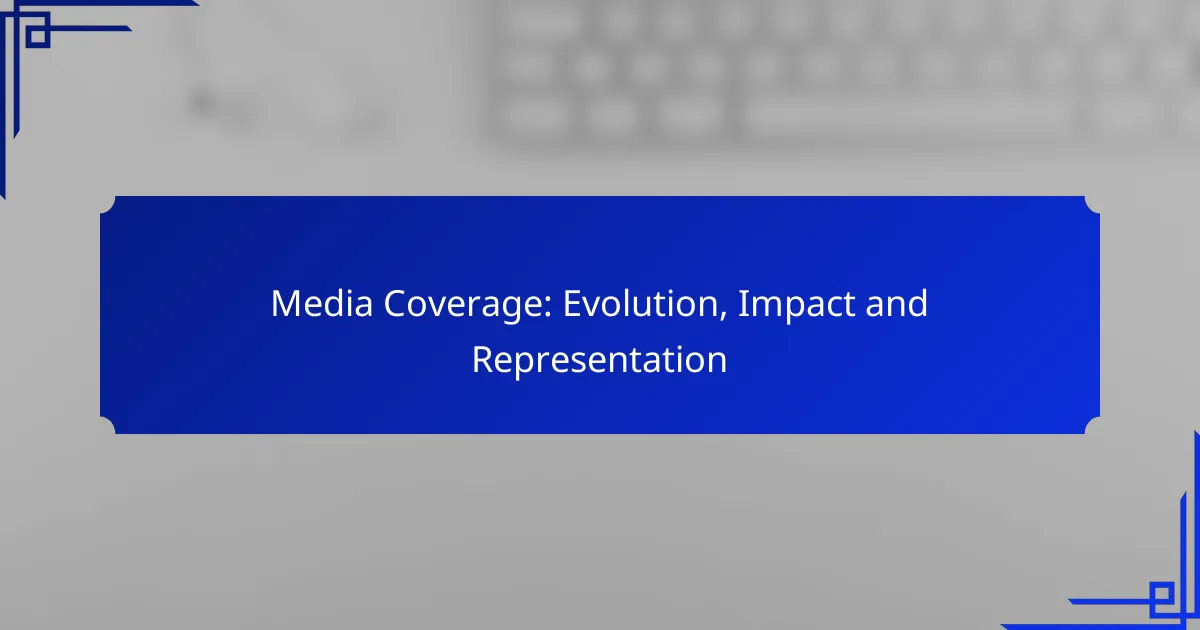The evolution of media coverage has shifted from traditional print formats to a multitude of digital platforms, fundamentally altering the way news is reported and consumed. This transformation not only reflects advancements in technology but also reshapes societal norms and public perceptions, influencing how individuals engage with current events and each other. Furthermore, the representation of marginalized communities in media plays a crucial role in shaping attitudes and can either empower or perpetuate harmful stereotypes.
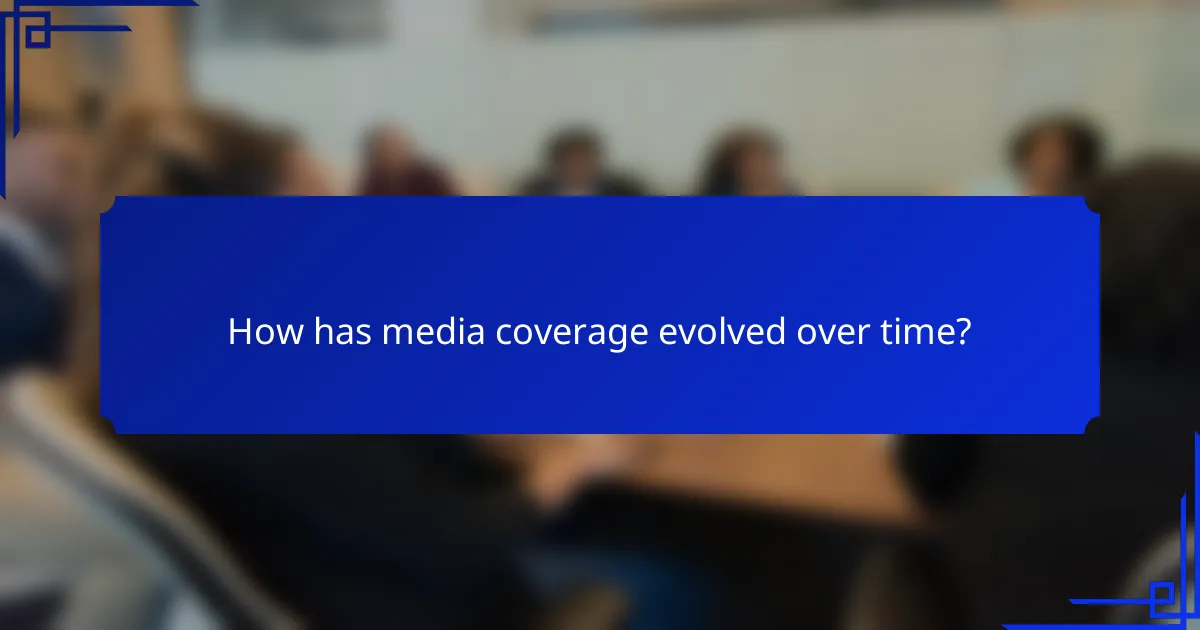
How has media coverage evolved over time?
Media coverage has evolved significantly, transitioning from print-centric formats to a diverse array of digital platforms. This evolution has transformed how news is reported, consumed, and interacted with, reflecting changes in technology and audience preferences.
Historical milestones in media coverage
The history of media coverage includes several key milestones that have shaped its current form. The invention of the printing press in the 15th century allowed for mass distribution of news, followed by the establishment of newspapers in the 17th century. The 20th century saw the rise of radio and television, which introduced real-time news broadcasting.
In recent decades, the internet has revolutionized media coverage, enabling instant access to information and the emergence of online news outlets. Social media platforms have further democratized news dissemination, allowing anyone to share information widely.
Technological advancements shaping media
Technological advancements have played a crucial role in the evolution of media coverage. The shift from analog to digital technology has enhanced the speed and efficiency of news reporting. High-speed internet and mobile devices have made news accessible anytime and anywhere, catering to the on-the-go lifestyle of modern audiences.
Additionally, the use of data analytics and artificial intelligence in journalism has improved content personalization and audience targeting. These technologies allow media outlets to tailor their coverage based on viewer preferences and behaviors.
Changes in audience engagement
Audience engagement has transformed dramatically with the evolution of media coverage. Traditional media relied on passive consumption, where audiences received information without interaction. Today, audiences actively participate in news discussions through comments, shares, and social media interactions.
This shift has led to a demand for more interactive and engaging content, such as live updates, polls, and multimedia storytelling. Media outlets must now consider audience feedback and preferences to remain relevant and maintain viewer loyalty.
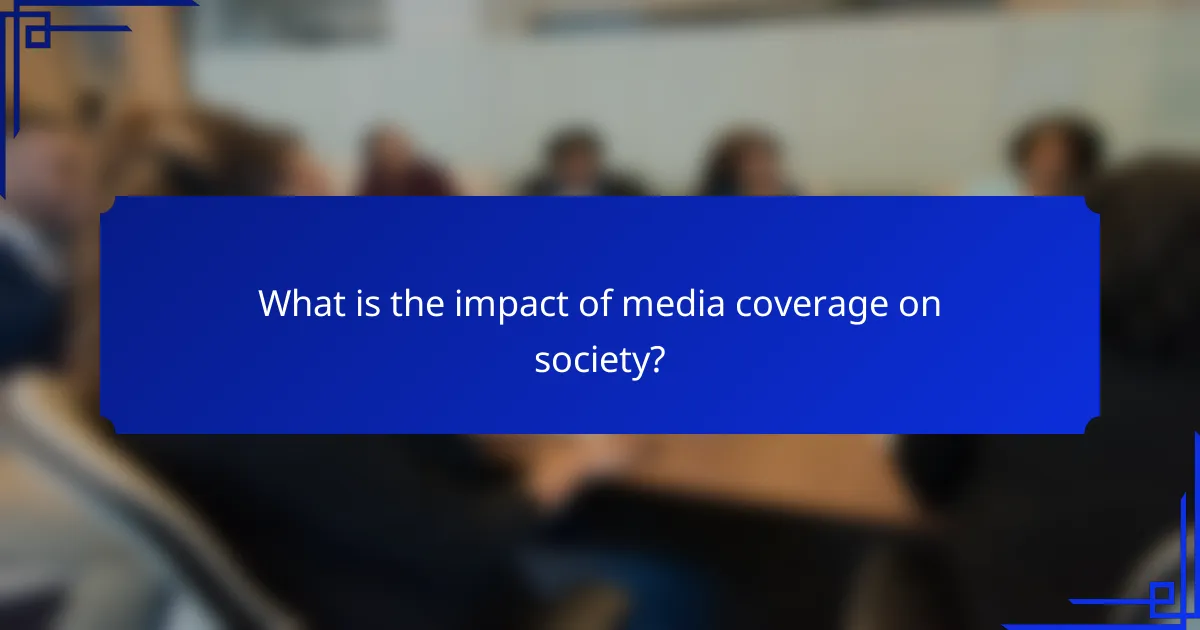
What is the impact of media coverage on society?
Media coverage significantly influences societal norms, behaviors, and perceptions. It shapes how individuals understand events, issues, and each other, ultimately affecting public discourse and decision-making.
Influence on public opinion
Media coverage plays a crucial role in shaping public opinion by highlighting specific issues and framing them in particular ways. For instance, extensive coverage of a social issue can lead to increased awareness and concern among the public, while minimal coverage may result in indifference.
Moreover, the portrayal of events in the media can create biases, influencing how people perceive different groups or situations. This can lead to polarized opinions, especially on contentious topics like immigration or climate change.
Role in shaping political narratives
Media coverage is instrumental in constructing political narratives that can sway voter perceptions and behaviors. Politicians often rely on media outlets to disseminate their messages, which can either bolster or undermine their public image.
For example, favorable media coverage can enhance a politician’s reputation, while negative reporting can lead to public distrust. The framing of political events, such as elections or scandals, can significantly impact the narratives that emerge and the subsequent political landscape.
Effects on social movements
Media coverage can amplify social movements by bringing attention to their causes and mobilizing support. When movements receive positive media attention, they often experience increased participation and funding, which can lead to greater impact.
Conversely, negative or misleading coverage can hinder a movement’s progress by misrepresenting its goals or actions. It is essential for social movements to engage with media strategically to ensure accurate representation and to counteract potential biases.
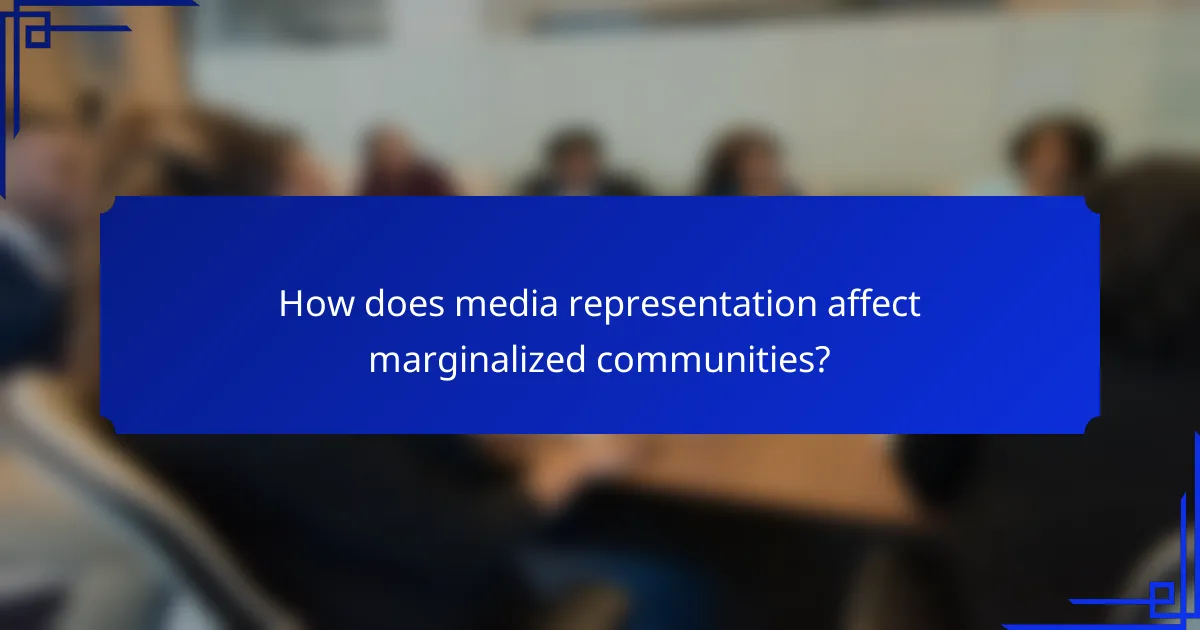
How does media representation affect marginalized communities?
Media representation significantly impacts marginalized communities by shaping public perceptions and influencing societal attitudes. Positive representation can empower these groups, while negative portrayals can perpetuate stereotypes and discrimination.
Representation in mainstream media
Mainstream media often reflects societal norms and values, which can marginalize certain groups. When underrepresented, these communities may struggle to have their stories told authentically. Increased visibility in films, television, and news can help counteract this trend and promote a more inclusive narrative.
For example, the rise of diverse characters in popular TV shows has led to broader acceptance and understanding of different cultures. This shift encourages networks to invest in more inclusive programming, which can further enhance representation.
Impact on cultural perceptions
The way marginalized communities are portrayed in media directly affects cultural perceptions. Positive representation can foster empathy and understanding, while negative stereotypes can reinforce biases and discrimination. Audiences often internalize these portrayals, influencing their views and interactions with these communities.
For instance, a study might show that increased representation of [censured] individuals in media correlates with higher acceptance rates in society. This highlights the power of media to shape cultural narratives and promote social change.
Case studies of representation
Case studies illustrate the tangible effects of media representation on marginalized communities. One notable example is the portrayal of Black characters in film and television, which has evolved from stereotypical roles to complex, multidimensional characters. This shift has contributed to greater acceptance and understanding of Black culture.
Another example is the representation of women in sports media. Increased visibility of female athletes has led to a rise in participation among young girls, demonstrating how positive representation can inspire future generations.
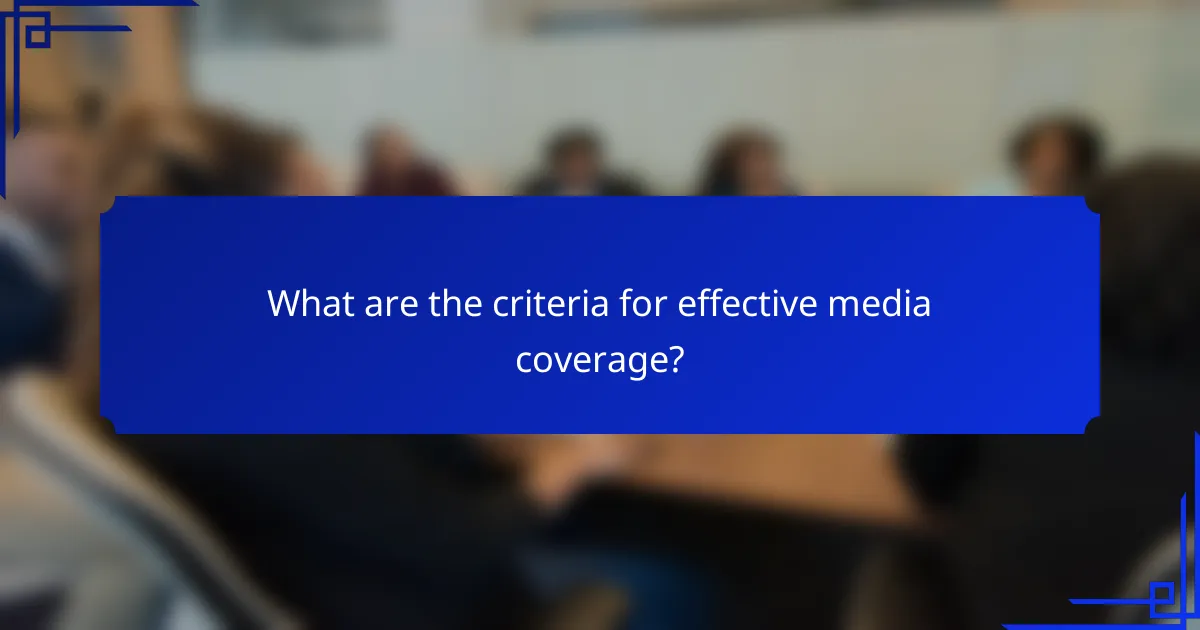
What are the criteria for effective media coverage?
Effective media coverage is characterized by accuracy, diversity of sources, and adherence to ethical standards. These criteria ensure that the information presented is reliable, comprehensive, and responsible, fostering trust among audiences.
Accuracy and fact-checking standards
Accuracy in media coverage involves verifying facts before publication to prevent misinformation. Journalists should utilize reputable sources and cross-check information against multiple outlets to ensure reliability.
Fact-checking standards often include using established databases and consulting experts in relevant fields. For instance, when reporting on scientific studies, referencing peer-reviewed journals can enhance credibility.
Diversity in sources and perspectives
Diversity in media coverage means including a range of voices and viewpoints to provide a well-rounded narrative. This can involve sourcing opinions from various demographic groups, regions, and expertise levels.
To achieve diversity, media outlets should actively seek out underrepresented communities and perspectives. For example, when covering social issues, incorporating insights from grassroots organizations can enrich the story.
Ethical considerations in reporting
Ethical considerations in reporting involve adhering to principles such as fairness, transparency, and accountability. Journalists must avoid conflicts of interest and disclose any potential biases that may affect their reporting.
Additionally, respecting privacy and sensitivity, especially in stories involving vulnerable populations, is crucial. Media organizations should implement guidelines that prioritize ethical decision-making in their coverage practices.
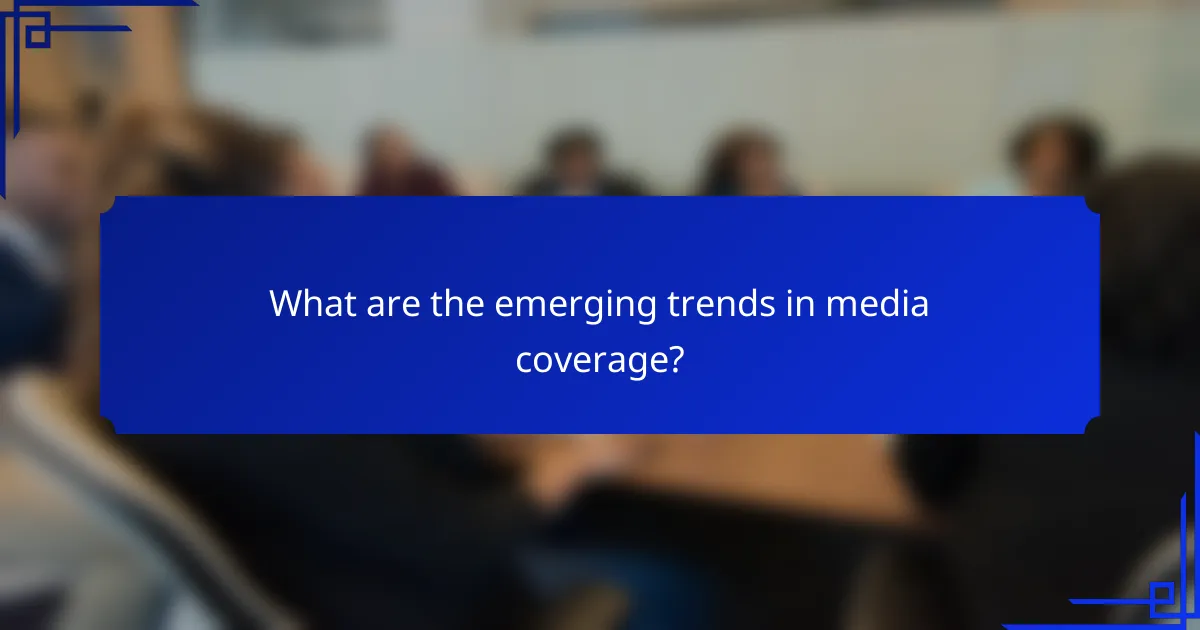
What are the emerging trends in media coverage?
Emerging trends in media coverage reflect significant shifts towards digital platforms, the influence of social media, and the evolving landscape of investigative journalism. These trends are reshaping how news is produced, consumed, and understood in contemporary society.
Rise of digital media platforms
The rise of digital media platforms has transformed traditional news dissemination methods. Online news outlets, blogs, and streaming services have become primary sources for many audiences, often prioritizing speed and accessibility over in-depth reporting.
As a result, media organizations are adapting their strategies to engage audiences through multimedia content, including videos, podcasts, and interactive articles. This shift requires journalists to develop new skills in digital storytelling and audience engagement.
Impact of social media on news dissemination
Social media significantly impacts how news is shared and consumed, allowing information to spread rapidly across networks. Platforms like Twitter, Facebook, and Instagram enable users to share news stories instantly, often leading to viral trends that can shape public opinion.
However, this rapid dissemination can also lead to misinformation and sensationalism. Journalists must be vigilant in verifying sources and providing context to ensure accuracy in their reporting.
Future of investigative journalism
The future of investigative journalism faces challenges and opportunities in the digital age. While funding for traditional investigative units may decline, new models are emerging, including nonprofit journalism and collaborative investigations among various media outlets.
Technological advancements, such as data analysis tools and crowdsourcing, are enhancing the capabilities of investigative journalists. These tools allow for deeper insights and more comprehensive stories, but they also require journalists to be proficient in new technologies and methodologies.
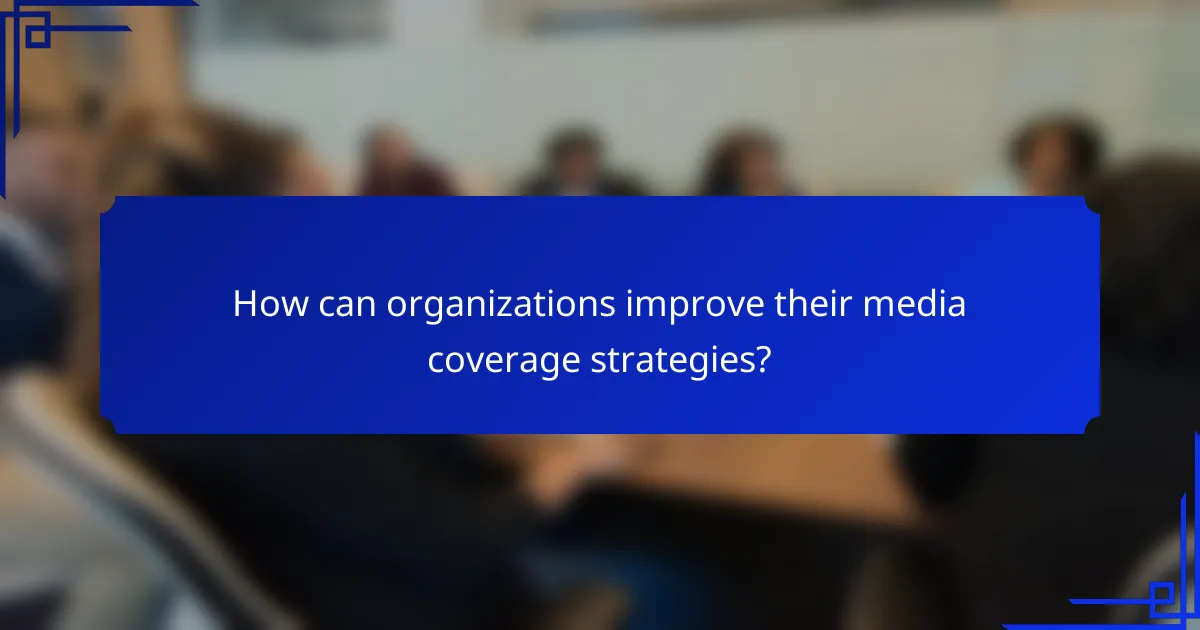
How can organizations improve their media coverage strategies?
Organizations can enhance their media coverage strategies by developing clear messaging, building relationships with journalists, and utilizing data analytics to understand audience engagement. Effective strategies involve proactive communication and adapting to the evolving media landscape.
Understanding the target audience
Identifying and understanding the target audience is crucial for effective media coverage. Organizations should analyze demographic data, preferences, and behaviors to tailor their messaging accordingly. This approach ensures that content resonates with the intended audience, increasing the likelihood of media pickup.
Building relationships with journalists
Establishing strong relationships with journalists can significantly improve media coverage. Organizations should engage with reporters through networking events, social media, and direct outreach. Providing valuable information and being responsive to inquiries fosters trust and encourages journalists to cover stories more favorably.
Utilizing data analytics
Data analytics plays a vital role in refining media coverage strategies. Organizations can track engagement metrics, such as shares, comments, and views, to assess the effectiveness of their content. By analyzing this data, they can make informed adjustments to their strategies, ensuring they meet audience expectations and maximize impact.
Creating compelling narratives
Crafting compelling narratives is essential for capturing media attention. Organizations should focus on storytelling that highlights unique angles, human interest elements, or relevant societal issues. A well-structured narrative not only attracts media interest but also engages the audience, making the message more memorable.
Monitoring media coverage
Regularly monitoring media coverage helps organizations understand their public perception and identify areas for improvement. Tools like media monitoring software can track mentions across various platforms, allowing organizations to respond quickly to coverage and manage their reputation effectively.
